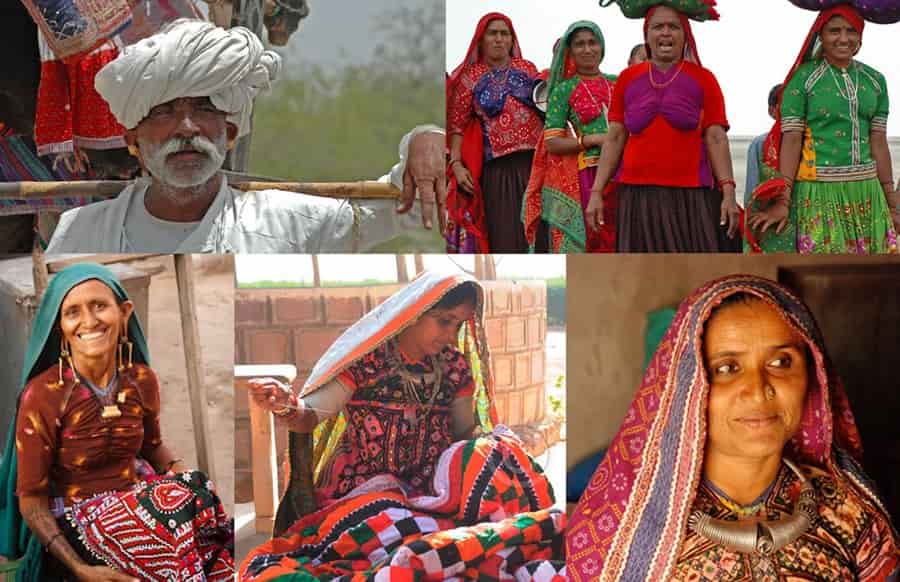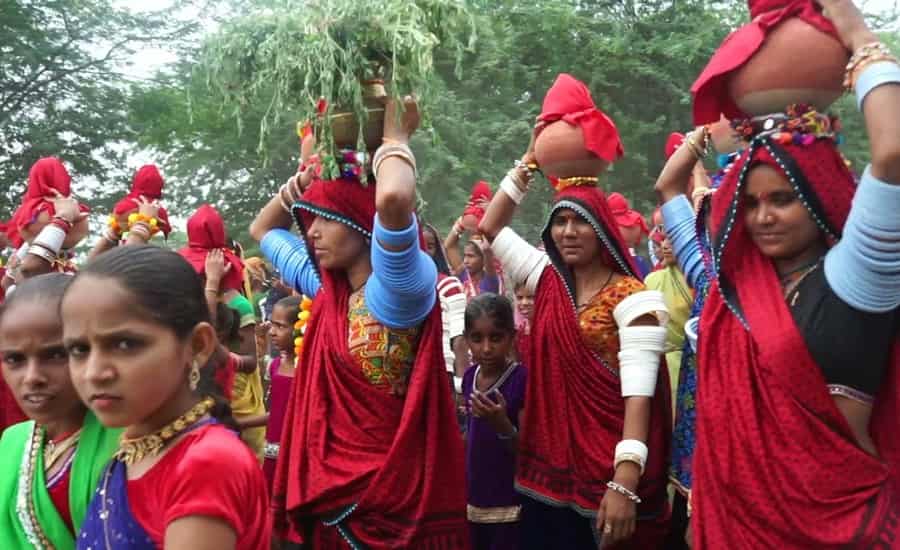The Rabari tribe, also known as the Raika or Rewari, is a nomadic or semi-nomadic community indigenous to the Indian subcontinent. With a rich cultural heritage dating back centuries, the Rabari people have a distinctive way of life, marked by their nomadic pastoralism, unique traditions, and vibrant rituals. In this comprehensive exploration, we delve into the origins, culture, traditions, and rituals that define the Rabari tribe.

Origins
The exact origins of the Rabari tribe are shrouded in the mists of time, making it challenging to pinpoint their precise historical roots. However, scholars believe that the Rabaris have ancient connections to the Rajputs, a warrior caste in India. Over the centuries, the Rabaris evolved into a distinct community with a nomadic lifestyle centered around herding and trading livestock.
Culture
The Rabari culture is deeply intertwined with their pastoral lifestyle and is characterized by a strong sense of community, oral traditions, and a unique social structure. The community is organized into clans, and each clan has its own customs and rituals. The Rabari society is traditionally patriarchal, with elders playing a significant role in decision-making.
Livelihood and Nomadic Lifestyle
The primary occupation of the Rabari tribe revolves around animal husbandry, particularly the rearing of camels, goats, and sheep. The vast Thar Desert in western India serves as their traditional habitat, where they move with their herds in search of grazing lands and water sources. This nomadic lifestyle has shaped their cultural identity and is reflected in their customs and rituals.
Traditional Dress and Ornaments
One of the distinctive features of Rabari culture is their traditional attire and elaborate ornaments. Women wear brightly colored ghaghras (long skirts) and cholis (blouses) adorned with intricate embroidery and mirror work. Men typically wear dhotis and kurtas. Both men and women are known for their jewelry, which includes silver necklaces, earrings, nose rings, and bangles. The ornate attire and jewelry are not only a symbol of cultural identity but also a testament to the community’s craftsmanship.

Marriage Customs
Rabari marriages are elaborate affairs marked by age-old customs and rituals. The community practices endogamy, preferring to marry within their own clan. The matchmaking process involves the exchange of horoscopes and the consultation of elders. The wedding ceremony itself is a colorful and joyous event, featuring traditional music, dance, and rituals. The newlyweds often move in with the groom’s family, and joint families are a common social structure among the Rabaris.
Festivals and Celebrations
The Rabari community celebrates a variety of festivals with great enthusiasm, adding vibrant colors to their nomadic lifestyle. Diwali, Holi, and Gangaur are among the major festivals celebrated by the Rabaris. During these occasions, the community comes together to participate in rituals, traditional dances, and feasts. The festivals also provide opportunities for socializing and strengthening community bonds.
Religious Practices
The Rabari tribe follows a syncretic blend of Hinduism and animistic beliefs. They worship a variety of deities, including the goddess Ban Mata, who is considered the protector of camels. Temples dedicated to Ban Mata are found in many Rabari settlements, and rituals involving the worship of animals are common. The community also observes religious fairs, where they seek blessings for their livestock and well-being.
Nomadic Traditions and Rituals
The nomadic lifestyle of the Rabari tribe is accompanied by a set of unique traditions and rituals. Migration routes are carefully planned to ensure the well-being of the livestock, and certain sacred sites are visited during these journeys. The community has traditional songs and folk tales that are passed down through generations, serving as a repository of their history and cultural identity.
Challenges and Adaptations
In the modern era, the traditional nomadic lifestyle of the Rabari tribe faces numerous challenges, including land encroachment, changing agricultural practices, and government policies. Many Rabaris have had to adapt to a more settled life, engaging in alternative livelihoods while striving to preserve their cultural heritage. Non-governmental organizations and activists are working to address the socio-economic issues faced by the community and promote sustainable development.
1- Land Encroachment and Displacement:
- Challenge: The Rabaris traditionally rely on vast grazing lands for their livestock, but these lands are increasingly under threat due to urbanization, agricultural expansion, and government policies.
- Adaptation: Some Rabari families have been forced to settle in one place, abandoning their nomadic lifestyle. Others seek legal assistance or collaborate with advocacy groups to protect their ancestral lands.
2- Changing Agricultural Practices:
- Challenge: Shifts in agricultural practices and land use impact the availability of grazing lands, reducing the resources essential for the Rabari’s livelihood.
- Adaptation: Some Rabari families have diversified their livelihoods by engaging in alternative occupations such as farming, handicrafts, or working in local industries. This adaptation allows them to cope with the changing economic landscape.
3- Government Policies and Regulations:
- Challenge: Government policies often do not align with the nomadic lifestyle of the Rabari tribe, leading to issues related to land rights, education, and access to basic amenities.
- Adaptation: Advocacy groups and NGOs work with the Rabari community to raise awareness about their unique needs and negotiate with authorities for policies that accommodate their nomadic way of life. Educational initiatives are also undertaken to bridge the gap between formal education and the traditional knowledge of the Rabari people.
4- Socio-economic Issues:
- Challenge: The nomadic lifestyle, while culturally rich, can be economically challenging. Limited access to healthcare, education, and employment opportunities contribute to the socio-economic struggles faced by the Rabari community.
- Adaptation: Efforts are made to provide skill development and vocational training to the Rabari youth, enabling them to integrate into the mainstream economy while preserving aspects of their cultural identity.
5- Environmental Changes:
- Challenge: Climate change and environmental degradation affect the availability of water and grazing lands, posing a threat to the Rabari’s livestock-dependent livelihood.
- Adaptation: Some Rabari families are exploring sustainable practices such as rainwater harvesting and efficient resource management to cope with environmental challenges. Additionally, awareness programs educate the community about climate-resilient practices.
6- Educational Opportunities:
- Challenge: Limited access to formal education for nomadic communities hinders their socio-economic progress and the transmission of traditional knowledge to younger generations.
- Adaptation: NGOs and community-led initiatives are working to establish mobile schools, providing education to children as they move with their families. Efforts are also made to bridge the gap between formal education and traditional Rabari knowledge.
7- Cultural Preservation:
- Challenge: Globalization and modernization pose a threat to the preservation of Rabari culture, language, and traditions.
- Adaptation: Cultural preservation initiatives, including documentation of oral traditions, promotion of traditional crafts, and celebration of festivals, help to safeguard the Rabari cultural heritage. Tourism and cultural exchange programs are also leveraged to create awareness and appreciation for Rabari traditions.
Conclusion
The Rabari tribe’s origins, culture, traditions, and rituals are woven into the fabric of India’s rich tapestry of diversity. Their nomadic lifestyle, vibrant festivals, and unique customs make them a fascinating community with a deep connection to the land they have traversed for centuries. As the Rabari tribe navigates the challenges of the modern world, efforts to preserve and celebrate their cultural heritage play a crucial role in ensuring the continuity of this ancient way of life.
FAQ’s
1. Who are the Rabari people?
Ans: The Rabari people are a pastoral community native to the western Indian states of Gujarat, Rajasthan, and parts of Punjab and Haryana. They are traditionally known for herding livestock and have a distinctive cultural identity.
2. What is the traditional livelihood of the Rabari tribe?
Ans: The Rabari tribe traditionally relies on herding cattle, sheep, and goats. They are skilled in animal husbandry and often lead a nomadic or semi-nomadic lifestyle in search of grazing land.
3. What is unique about Rabari dress and adornments?
Ans: Rabari women are often recognized by their vibrant and elaborate traditional attire, which includes colorful skirts, embroidered blouses, and distinctive jewelry. Men typically wear white attire with turbans and accessories.
4. What is Rabari embroidery known for?
Ans: Rabari embroidery is renowned for its intricate patterns and vibrant colors. Women of the tribe are skilled in various embroidery techniques, and their work often reflects their cultural identity and stories.
5. How is the Rabari community organized socially?
Ans: The Rabari community is organized into clans, each with its own social and economic responsibilities. Clans are further divided into extended families, and social customs play a crucial role in their society.
6. What is the religious belief of the Rabari tribe?
Ans: The Rabari tribe follows a syncretic blend of Hinduism and their indigenous folk religion. They have their own deities and rituals, often centered around nature and animals.
7. Do Rabari people celebrate festivals?
Ans: Yes, Rabaris celebrate various festivals with enthusiasm. Important festivals include Holi, Diwali, and Navratri, during which the community comes together to celebrate with traditional music, dance, and rituals.
8. How has the lifestyle of the Rabari tribe evolved over time?
Ans: While traditionally nomadic, many Rabari families have transitioned to a more settled lifestyle in modern times. However, they still maintain strong ties to their pastoral roots, and aspects of their cultural identity persist.
9. What are some traditional crafts of the Rabari people?
Ans: In addition to embroidery, Rabari people are known for crafting handmade goods such as textiles, jewelry, and other traditional artifacts. These crafts often showcase their artistic skills and cultural heritage.
10. Are there specific rituals or customs associated with Rabari weddings?
Ans: Yes, Rabari weddings involve a series of traditional rituals and customs, including ceremonies that symbolize the union of two families. Marriages are often arranged within the community, and customs vary based on regional practices.
- Also Read: List of Scheduled Tribes in Gujarat
